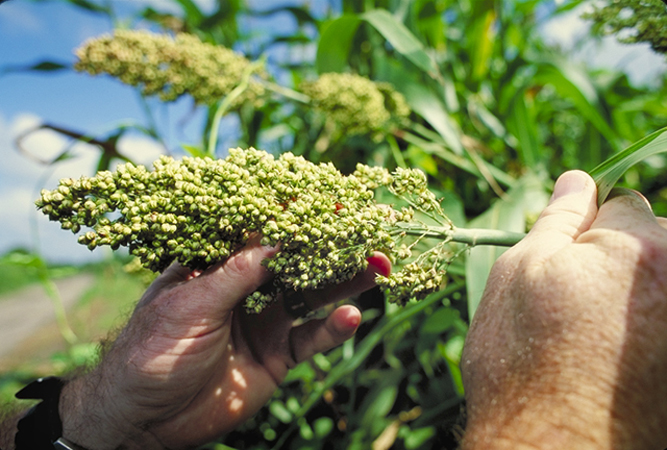Share This
Search the term “sorghum” in Google News, and you’ll receive over 60,000 stories featuring our June Grain of the Month. Sorghum has been in the news a lot lately, but it seems it is still one of the lesser known grains.
Even though many may have never heard of sorghum, it is actually one of the top five most important cereal crops in the world. It’s produced not only as food, but as feed and fuel, as well. It is a drought tolerant, gluten-free crop originating from Egypt. Although a third of the world’s sorghum is still produced in Africa, it is also now cultivated in a variety of places throughout Asia, Latin America and North America. In the U.S. alone, 8.5 million acres of sorghum were planted last year across the “Sorghum Belt”, running from South Dakota to Southern Texas. It’s a truly versatile crop; agronomist Jack Harlan referred to sorghum as “’one of the really indispensable crops required for the survival of humankind”.
People are catching on to sorghum. Doug Bice, Market Development Director for the United Sorghum Checkoff Program, told us, “There’s a big boom in sorghum. Demand is outrunning supply. We’ve seen a 40% growth in human consumption of sorghum, as we emphasize its benefits, including as a prebiotic for digestive health”. Good taste is part of the picture too, so take a look at some of the delicious recipes on Sorghum Checkoff’s website.
While sorghum is a nutritious choice, its benefits go beyond our plate: it’s a highly-sustainable alternative for feedstock and biofuel. Some day, you could pull up to the pump and fuel your car with sorghum. Last week, The Sorghum Checkoff announced a $500,000 investment in research into sorghum as liquid fuel, at the Transportation Energy Resources from Renewable Agriculture (TERRA) program field day at the University of Arizona’s Maricopa Agricultural Center. This investment comes on top of a $30 million investment the U.S. Department of Energy made last year. Both investments aim to transform crop breeding and advance biofuel production.
Building on this news, also last week, scientists from the ARC Centre of Excellence in Plant Cell Walls at the University of Adelaide have discovered that a variety of sorghum growing wild in Australia has strong potential for biofuel production. Beyond these findings, scientists believe there exists an untapped diversity in other species of sorghum to produce large quantities of biofuel much more efficiently than corn ethanol.
People are finding new ways to use sorghum all the time. With all of this recent news and promising potential, sorghum could be taking off as the next big thing. While we’re intrigued by the biofuel angle, we are of course most interested in delicious ways to eat sorghum. What are some of your favorite or unique ways to use this multi-talented whole grain?
(Harley)


Add a Comment